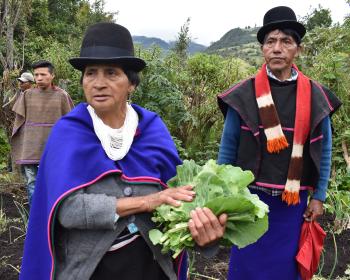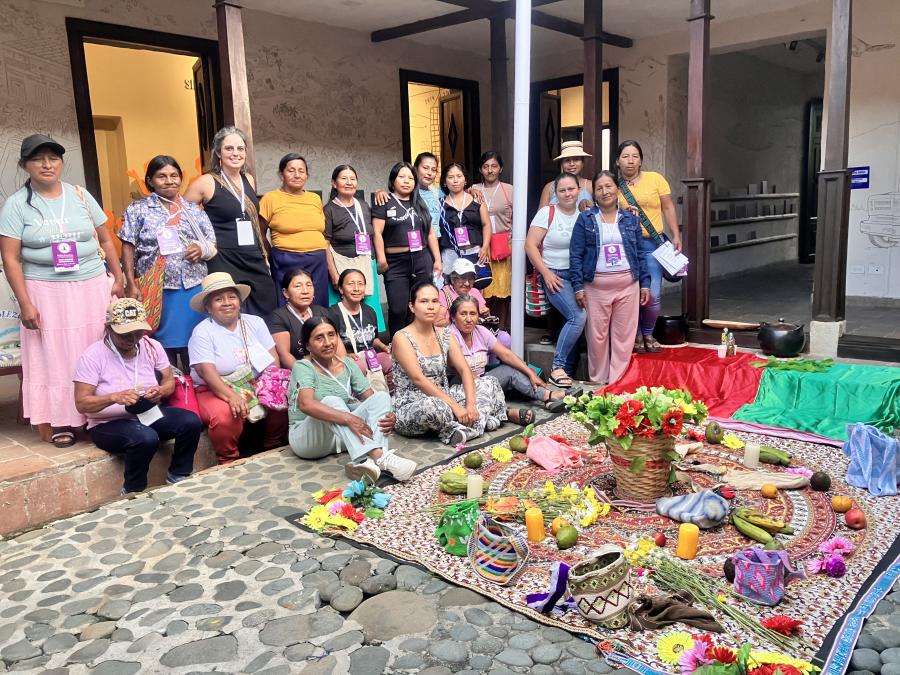The Colombian conflict has spilled over to all of its neighboring countries. Ecuador, which shares a 560-kilometer border with Colombia (with only three official checkpoints), has been the most affected of Colombia’s neighbors. Of Ecuador’s three northern-border provinces, Sucumbíos, located in the Ecuadoran Amazon south of the Colombian department of Putumayo, has experienced the most dramatic impact. Home to indigenous Cofán, Siona, Secoya, Quichua, and Shuar villages, Sucumbíos was the site of an intense land rights battle between indigenous groups, the Ecuadoran government, and petroleum companies.The fight for indigenous survival continues with Plan Colombia.
Sucumbíos was previously heavily dependent on commercial exchange with Colombia, and still has many ties to the country. Dollarization has made Ecuador’s exports less competitive, and feelings of insecurity have slowed cross-border trading. This region has also recently become the scene of cross-border skirmishes between the FARC and the Colombia and Ecuador armies. While there is little evidence of coca production in Ecuador, it has become a significant transit route for drugs and weapons. Fumigations nevertheless threaten human health and the environment. The FARC have long used villages in Ecuador to rest and recuperate. The large number of refugees and other displaced persons moving into the region from Colombia has become a social and security problem as well.
Largely in response to the violence, many indigenous peoples and mestizos have left their homes and migrated further south. Entire indigenous villages have relocated due to the conflict. Two Quichua communities were forcibly displaced from their villages on the border in February 2001 after receiving threats from armed (presumably Colombian) groups. Many members of a Shuar community on the border have also been displaced for security reasons, leaving the remaining Shuar to question their fate in this environment.
About 20 years ago, a number of Shuar families, originally from the Amazonian province of Morona-Santiago in Ecuador, moved to Sucumbíos, wooed by the availability of land and the hope of temporary petroleum work. The first Shuar arrived in the zone looking to increase their territory. The first six Shuar centers, each comprising a number of families, were located in the Cascales canton on the border with Colombia. There are now 20 communities spread over three cantons in Sucumbíos.
According to community leaders, the Shuar lived in relative peace for more than 20 years in their new home. However, most agree that the tranquility was shattered on October 12, 2000, when a group of petroleum technicians were kidnapped near their villages. Originally blamed on guerrilla or paramilitary groups, the kidnapping was later attributed to a group of criminals. However, the kidnapping provoked suspicion of the community’s involvement with the FARC, and led to a more active and involved presence by the Ecuadoran military in their villages. According to a number of Shuar leaders, Ecuadoran military began to patrol the zone and frequently visited the Shuar communities of Etsa and Taruka looking for information about guerrillas and paramilitaries purported to be staying on Shuar territory. Many Shuar claim the military offered candy to children in exchange for information about the actions of their parents.[1] The Center for Documentation of Human Rights, based in Quito, reports these were illegal means of gaining information. This personal testimony illustrates the dilemma faced by the Shuar villages remaining in Sucumbíos, and the uncertain future of this man’s transplanted indigenous community. Although this Shuar leader is eager to tell his story, security concerns mandate that his name, title, and village remain anonymous.
My community was one of the first to resettle in Sucumbíos. We now have our own political organization and our own leaders. I have lived in Sucumbíos for seven years, and up until now I haven’t seen any FARC. Some friends who live further in have seen them, but they can’t say anything because the Ecuadoran Armed Forces will punish them. They think that we are also part of the FARC, that we are helping them. The Ecuadoran military came, and they told us it was to guard us. But I know it was to see if the Shuar were in contact with the FARC. We know that the FARC have been entering our territory for some time, using it as a place of rest. The Ecuadoran military come in and patrol; they too know that the FARC have been in and out of here for a long time.
One Shuar village returned to the province of Morona Santiago with the help of the Ecuadoran army. The village left not because of direct threats on their lives, but because of fear of such threats. They probably will never return. Their land has been sold to colonos (mestizo or white settlers of the Amazon). Only one family from that village stayed, but they are living in an urban center, amid a settler village.
The village left 2,000 hectares. It is so close to the border that the Ecuadoran military or the FARC could have made a mistake and decided that community was part of the problem. We are defenseless. We are only armed with machetes. They could come in the day, in the afternoon, in the evening. We are not committed to either side. Not the Ecuadoran army, nor the FARC, nor the paramilitaries, nor the other armed forces. We are a zone of peace. We have made clear to the Ecuadoran army that if they want to do their job, they can patrol Ecuadoran territory, but without involving us in anything. The Ecuadoran army has threatened Shuar for information about the FARC. They have tortured us, but there have been no killings yet. If there are, we will retaliate. Some Shuar have supported FARC kidnappers by giving food to the FARC and letting them stay on their land. However, they were threatened with their lives if they did not do that. Now we are threatened by the Ecuadoran military for helping the FARC. We are open to an innocent, sincere dialogue, where we also can be heard.
After the first Shuar village left, a lot of other villages considered leaving, too. However, we have 32,000 hectares of land here. If we leave, we probably won’t ever get it back. I have a brother-in-law who lives a few hours away, further from the border. My family wanted to go live with him, but I didn’t. My wife didn’t want to leave me, so she and the children stayed. If our village left, maybe one or two families could find work. But what about the rest of us? We can’t abandon our lands, our families. The pride of the Shuar is that we have never been conquered. I don’t want the Shuar of Sucumbíos to just be history. We have to defend the land, we have to fight.
I don’t mind if there are FARC on the land that we are not using. It’s when they go into homes and demand food and lodging; then there is a problem. I want to go speak to the FARC, and tell them to leave the houses alone. They can stay peacefully in the territory we are not using, but not in our homes. Those who suffer the most are the children, because they are not accustomed to a life of fearing the FARC. Many of them want to leave and go to other places. If we disperse we lose our culture, which is worse than losing our land or our lives. Children are already forgetting what it means to be Shuar. They may kill my family someday, but I want them to leave me till the end, so that I can see everything they have done. Then they can kill me.
1. "Riesgos para los Derechos humanos del Pueblo Shuar en la Frontera Norte del Ecuador," Bulletin from the Centro de Documentación en Derechos Humanos "Segundo Montes Mozo S.J.," the Colectivo Pro Derechos Humanos, the Comité Andino de Servicios, and the Iglesia de San Miguel de Sucumbíos, August 2001, p. 4.
Judith Walcott (judith_walcott@yahoo.com) is a graduate of Tufts University and a former intern at Cultural Survival. She spent the last year in Ecuador on a Fulbright grant studying the effects of border conflicts on Ecuador’s indigenous peoples.


